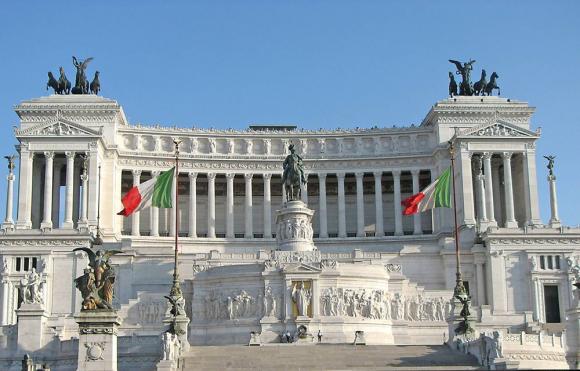When we talk about national unity, we tend to remember the main protagonists. Next to the names of Cavour, Garibaldi, Gioberti ... the first decades of Italian unitary history were intimately linked to the figure of Vittorio Emanuele II. Gravestones, monuments, squares, streets and even cities were dedicated to the first ruler of the Kingdom of Italy.
When the 4 June 1911 the Victorian was inaugurated to celebrate the first 50 years of national unity, in fact territorial Italy was not yet fully accomplished. It could only appear as a mere coincidence, but only after years of exhausting war, the conquest of the unredeemed lands was obtained at about 600 km from the capital in October-November 1918, with the battle Vittorio Veneto.
The subsequent "squaring of the circle" will then take place in the 1921, with the transposition of the remains of the unknown soldier at the Vittoriano. From that moment, beyond the ideological reconstructions or propagandistic manipulations, the "patriotic forum" became unequivocally no longer a royal monument, but the main place of national memory. Where the highest authorities of the State pay a reverent tribute to all the fallen for the Fatherland.
The Altar of the Fatherland is the perfect synthesis of the union of Institutions, Armed Forces and Homeland. At this point it would be interesting to investigate to what extent this feeling is shared and widespread in the national social fabric.
The spotlight on the celebrations in memory of the Great War will soon be extinguished. Instead, it is desirable to start a new cycle of cultural initiatives for to give new impetus to the memory of the day of national unity and its Armed Forces. An event that risks becoming even anachronistic or "sectarian", especially if the needs of society are changing.
Over the last century, despite numerous events epoch making, while the institutions have undergone substantial transformations, our Armed Forces have remained unchanged in absolute value. Certainly the operational commitments and the way of making war are no longer the same. From instrument to power, we have moved to a modern, professional, interoperable and projectable device. Yet as has been pointed out recently by the political summit, the values of the past still continue to animate women and men with stars.
Two years are missing for the centenary of the end of hostilities. The 11 November 1918 represented a fundamental step for the territorial, historical, social and institutional adjustment of the entire old Europe. In this perspective, in light of national and world transformations, it becomes essential to investigate history in order to identify our roots and the deeper meaning of that period. A "hard core" of identified lessons that can be useful for future generations.
With reference to the current international arena, due to high dynamism and entropy, the near future seems to be characterized by numerous uncertainties. And underlying this thematic arc emerges, for example, the risk of compromising the optimal relationship between the Institutions and the Armed Forces.
A very topical issue that requires the development of further reflections. There are so many ideas to do it and art comes to meet us. To stay on the subject, the main staircase and the first balustrade of the Vittoriano are decorated with six groups of statues symbolizing the "civil values" of the Italian popopolo. Among these the most significant for the purposes of this work is the bronze work of Giulio Monteverde: the "Thought".
Completed in the 1911, the "Thought" shows itself rich in meanings that go far beyond the artistic perspective. From a symbolic point of view, in fact, elements that refer to Mazzinian philosophy are clearly visible.
Following his exceptional Renaissance style sculptural style, Monteverde managed to capture the moment: the completion of the Risorgimento process and therefore of the birth of a united Italy. After centuries of submission, finally free, thought (in its various forms) it opened its wings and guided the people towards new great deeds. One of these, as mentioned, was the completion of the unitary process and the conquest of the unredeemed lands.
To achieve and maintain the condition of freedom, it was necessary to equip and invest in a regular Army. In the Piedmontese artist's vision, that's it the angel of war has a dual posture. Behind the shield he has a defensive attitude. At the same time, by sharpening the blade of the sword, it shows itself pro-active in safeguarding the free institutions.
Looking at it in its entirety, it is clear that in this composition nothing is left to chance. The volumes, figures, positions, symmetries and their movements are dosed with sobriety and in a masterly way. And in order for everything to work, the democratic political institutions have the task of guiding the Armed Forces. A perfect alchemy that must be constantly animated by a third element: love of country. A feeling that actually refers toNational unity, essential to channel and harmonize the active energies of society. Therefore, the fight against sterile parochialism (represented by Discordia) becomes necessary to avoid the germination of internal divisions. A dangerous premise for the tyrannical / totalitarian tendencies, which still today threaten stability and world order.
In the light of the present symbolic reconstruction, the Monteverdian work, firmly focused on the indissoluble relationship between the two geniuses of society ("thought" and "war"), strips itself of the traditional space-time references. And, from a utopian perspective, by stimulating the search for a dimension of peace that can be extended worldwide, it even takes on a universal scope.
Thus, going beyond the traditional canons of historical representation, and equally fulfilling a predictive function, Monteverde's sculptural synthesis stands unequivocally as an extraordinary testimony of our historical and cultural heritage, to be enhanced and re-evaluated.
(photo: DO)












